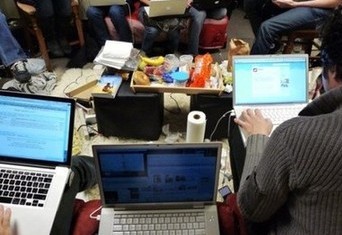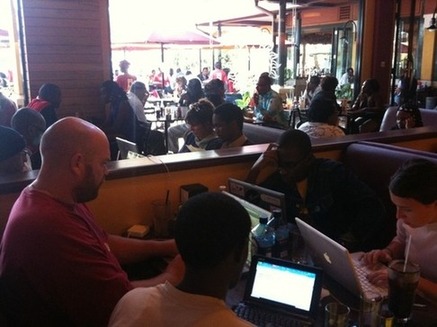 In Haiti relief organizations were facing bottleneck at the airport, but mobile phones and online crisis mapping tools
have enabled tech developers and volunteers to collaborate in other unprecedented ways. (Fletcher Ushahidi Situation Room)
In Haiti relief organizations were facing bottleneck at the airport, but mobile phones and online crisis mapping tools
have enabled tech developers and volunteers to collaborate in other unprecedented ways. (Fletcher Ushahidi Situation Room)
Tadias Magazine
By Tseday Alehegn
Published: Tuesday, January 19, 2010
New York (TADIAS) – When a 7.0 magnitude earthquake hit Haiti in the afternoon of Tuesday, January 12 and devastated the capital Port-au-Prince, the world community and international NGOs hastened to get aid to an estimated 3 million people affected. Buildings were leveled, roads blocked with rubble, and phone lines were down. Even as financial donations were being sent by concerned citizens the world over and frantic calls were made for Haitian Creole translators to help emergency workers on the ground, Western media was reporting that organizations were frustrated with lack of access to aid due to bottleneck at the airport, and USAID Administrator Rajiv Shah reported the need to “dramatically expand the in-country distribution network.” Tasks such as getting more accurate locations of those trapped or needing assistance, and directing NGO workers to those requests would be key in making sure that the aid that was pouring in was getting disbursed in a timely and efficient manner.
Today The Washington Post reports that “A record $22 million has been raised via text messages by the American Red Cross for relief efforts in Haiti, a groundbreaking statistic that could propel an important new avenue for philanthropy going forward.”
But there is something even more incredible happening. Mobile phones and online crisis mapping tools have enabled tech developers and volunteers to collaborate in other unprecedented ways.
Ushahidi – Crowdsourcing from Africa
While mobile phone providers in Haiti were scrambling to have their services up and running again, Erik Hersman Co-Founder of Ushahidi (a crowdsource information tool originally used in Kenya) blogged that Ushahidi is now “heavily involved in mapping and integrating crowdsourced information from Haiti into an aggregated map that is being used by both people on the ground who need help and those who can provide relief.”
“We’re running what’s basically the 911 system for Haiti through a local shortcode on the Digicel network 4636,” Hersman says. The 4636 SMS campaign team members are located in Kenya, Uganda, the United States and on the ground in Haiti. Ushahidi designers and developers are based in Canada, the Netherlands, and in several African countries including Kenya, Malawi, Ghana, and South Africa.
“It became clear we needed a local SMS short code to make mobile reporting more viable,” Hersman writes, so D.C. based Josh Nesbit (Co-Founder of FrontlineSMS:Medic) located exec of Haiti’s Digicel, (the leading mobile operator in Haiti) on Twitter, and connected Digicel command center with Ushahidi and U.S. Department of State. The result was a shortcode 4636 which Haitian subscribers could use to text their emergency requests. The texts received were then fed to an online database developed in collaboration with Palo Alto-based InSTEDD and Maryland-based DAI groups.
Boston-based Peter Meier, Director of Media & Partnerships at Ushahidi and PhD student at The Fletcher School at Tufts University, also blogs about the Ushahidi-Fletcher Situation Room and virtual collaboration to link volunteers and translators for the 4636 SMS campaign. He notes that approximately 10,000 Haitian online volunteers are translating the incoming SMS messages from Creole into English and assisting other 4636 SMS campaign volunteers in relaying information to NGOs on the ground in Haiti. “We really couldn’t do this project without the help of the Boston situation room. They are combing through the reports, getting updates via many different forms of media – basically making sense of a mountain of incoming data,” he writes.
Other virtual situation rooms are being set up as developers are coordinating a training session at the Fletcher school tonight to ensure continued reporting.
The 4636 shortcode is also being used to register mobile numbers of subscribers in order to send vital information to them such as where to seek medical, food, or other emergency assistance. Approximately seven aid organizations in Haiti including Red Cross, Clinton Foundation, and International Medical Corps are currently receiving the RSS feeds from Ushahidi’s 4636 SMS campaign.
Hersman says assistance is still needed to process incoming requests. To help please click here.
You can also use Change.org’s “How to Volunteer for Haiti Without Leaving Your Home” Tips.

6 of the Kenya team working at Ushahidi ad hoc situation room in a coffee
shop in Nairobi. (Photo at Twitter).
—-
Join the conversation on Twitter and Facebook.


























Dear Friends,
Thanks immensely for this excellent article! I myself have links to Haiti, Kenya, the Fletcher School, and Ushahidi: it is so uplifting to see these “woven together” in such an insightful and valuable way. That in itself is a map, in this case, of “hope”.
Despite these terrible tragedies, there are people and groups who care, and they have been able translate that caring into action for a better future. This is the “bright spot” we all need to make whatever contribution we can as individuals, or in any professional or organizational capacity. Otherwise, it all seems so overwhelming and beyond our capacity to address.
I’m passing this article along to a number of forums and groups, and please keep such wonderful news coming!
With all best wishes and blessings, Janet Feldman
Dear Tadias Magazine,
I found your article posted on the UNESCO website by a twitter. This is a fascinating information that needs to be widely shared. Besides the incredible tragedy in Haiti and the lack of timely logistical coordination on the ground, it is not only uplifting but also promising to witness this kind of global collaboration through hig-tech means of our day to assist the people in ground-zero. The method you have highlighted has positive implications on how we respond and deliver relief efforts to future natural and human disasters not only in Haiti but also all over the world. This needs to be perfected as we move forward.